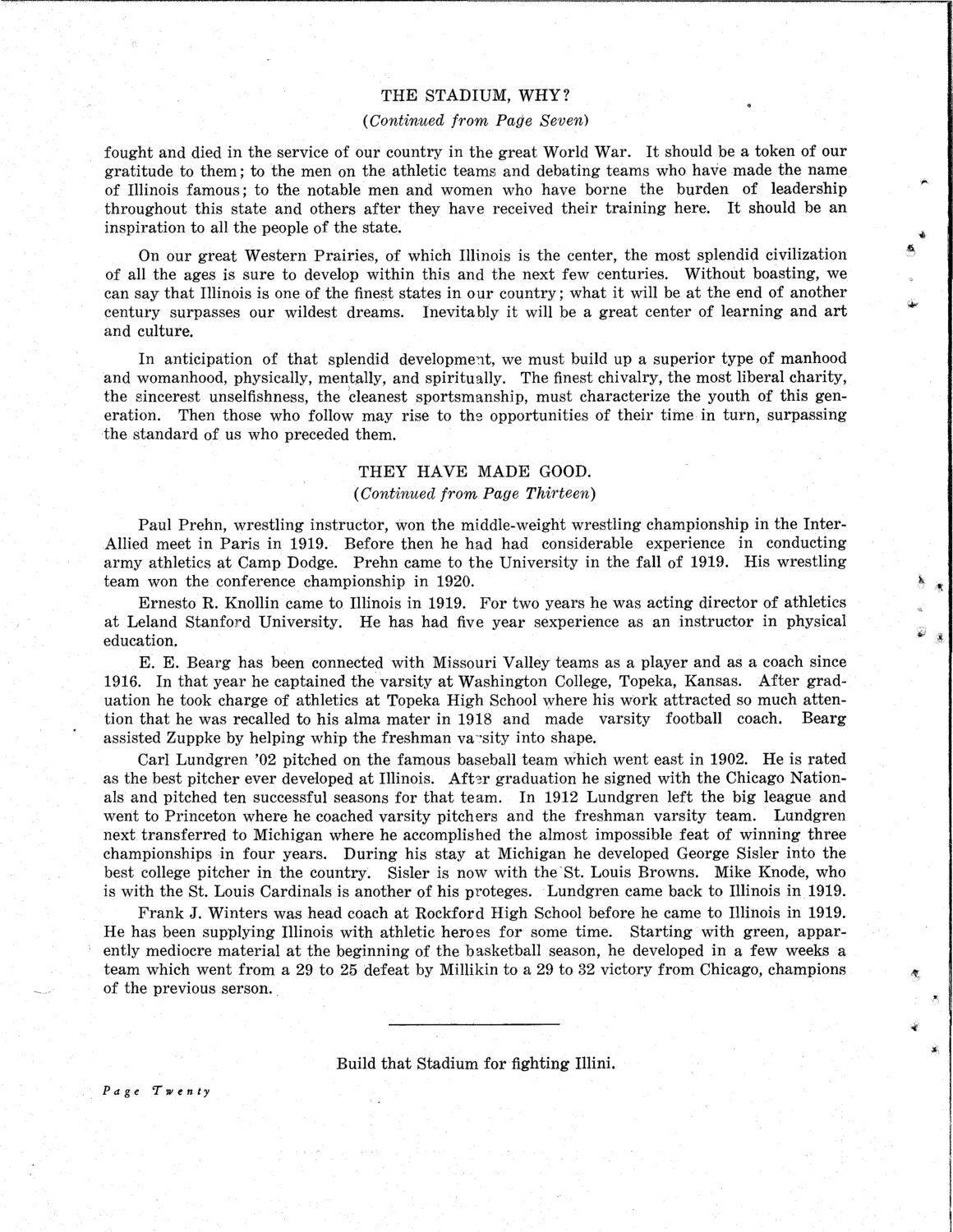| |
| |
Caption: Dedication - Memorial Stadium Drive Book #1
This is a reduced-resolution page image for fast online browsing.

EXTRACTED TEXT FROM PAGE:
THE STADIUM, WHY? (Continued from Page Seven) fought and died in the service of our country in the great World War. It should be a token of our gratitude to them; to the men on the athletic teams and debating teams who have made the name of Illinois famous; to the notable men and women who have borne the burden of leadership throughout this state and others after they have received their training here. It should be an inspiration to all the people of the state. On our great Western Prairies, of which Illinois is the center, the most splendid civilization of all the ages is sure to develop within this and the next few centuries. Without boasting, we can say that Illinois is one of the finest states in our country; what it will be at the end of another century surpasses our wildest dreams. Inevitably it will be a great center of learning and art and culture. In anticipation of that splendid development, we must build up a superior type of manhood and womanhood, physically, mentally, and spiritually. The finest chivalry, the most liberal charity, the sincerest unselfishness, the cleanest sportsmanship, must characterize the youth of this generation. Then those who follow may rise to the opportunities of their time in turn, surpassing the standard of us who preceded them. THEY HAVE MADE GOOD. (Continued from Page Thirteen) Paul Prehn, wrestling instructor, won the middle-weight wrestling championship in the InterAllied meet in Paris in 1919. Before then he had had considerable experience in conducting army athletics at Camp Dodge. Prehn came to the University in the fall of 1919. His wrestling team won the conference championship in 1920. Ernesto R. Knollin came to Illinois in 1919. For two years he was acting director of athletics at Leland Stanford University. He has had five year sexperience as an instructor in physical education. E. E. Bearg has been connected with Missouri Valley teams as a player and as a coach since 1916. In that year he captained the varsity at Washington College, Topeka, Kansas. After graduation he took charge of athletics at Topeka High School where his work attracted so much attention that he was recalled to his alma mater in 1918 and made varsity football coach. Bearg assisted Zuppke by helping whip the freshman varsity into shape. Carl Lundgren '02 pitched on the famous baseball team which went east in 1902. He is rated as the best pitcher ever developed at Illinois. Aftsr graduation he signed with the Chicago Nationals and pitched ten successful seasons for that team. In 1912 Lundgren left the big league and went to Princeton where he coached varsity pitchers and the freshman varsity team. Lundgren next transferred to Michigan where he accomplished the almost impossible feat of winning three championships in four years. During his stay at Michigan he developed George Sisler into the best college pitcher in the country. Sisler is now with the St. Louis Browns. Mike Knode, who is with the St. Louis Cardinals is another of his proteges. Lundgren came back to Illinois in 1919. Frank J. Winters was head coach at Rockford High School before he came to Illinois in 1919. He has been supplying Illinois with athletic heroes for some time. Starting with green, apparently mediocre material at the beginning of the basketball season, he developed in a few weeks a team which went from a 29 to 25 defeat by Millikin to a 29 to 32 victory from Chicago, champions of the previous serson. Build that Stadium for fighting Illini. Page Twenty
| |